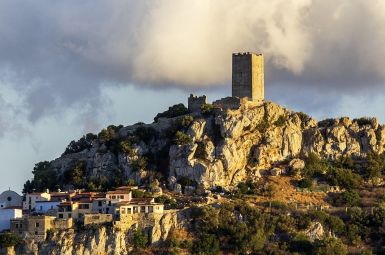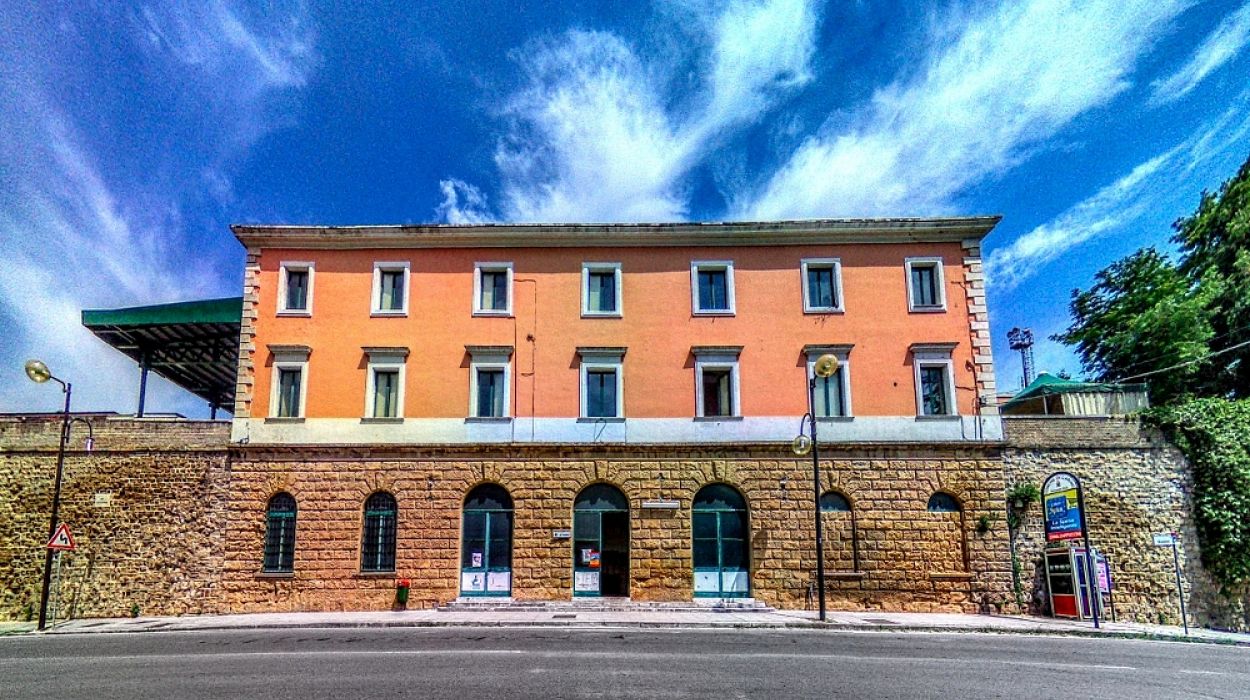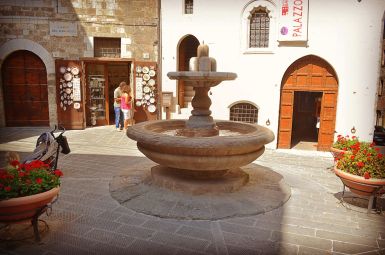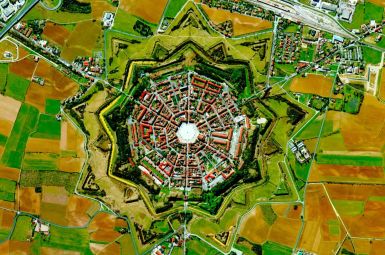
Il Borgo di Larino

Il Borgo d’Italia
tutto da scoprire ed esplorare
Monumenti
La storia
Larino sorge sul piano di San Leonardo, una zona ricca di testimonianze storiche che raccontano la presenza di insediamenti umani risalenti alla preistoria. La fondazione della città di Larino è molto antica e risale a cinquecento anni prima delle fondazione di Roma. Le sue origini si devono ai Frentani una popolazione di origine sannitica che fondò Frenter. Questo primo nucleo abitativo è stato distrutto e rifondato in seguito con il nome di Ladinod, modificato più volte nel corso dei secoli fino ad arrivare a diventare “Larino” nel XIX secolo.
In epoca romana Larinum è stato un municipio molto importante, ne sono testimonianza diretta le numerose terme sparse per il territorio comunale ma soprattutto l’imponente anfiteatro. Negli anni dell’Impero a Larino giunse persino l’avvocato Marco Tullio Cicerone, tra i più importanti autori della letteratura latina, che nel foro della città nel 66 a.C pronunciò la celebre orazione Pro Aulo Cluentio Habito, in difesa di Aulo Cluentio, patrizio romano accusato di omicidio.
Negli anni della seconda guerra punica, 219-201 a.C., l’esercito guidato da Annibale si è scontrato con il dittatore di Larino, Fabio Massimo.
L’avvento dei Longobardi in Italia ha portato ad un ridimensionamento nell’importanza della città, che è rientrata nei possedimenti di Benevento ed è diventata capitale di una delle trentaquattro contee in cui è stato diviso il territorio.
Nella storia di Larino sicuramente si deve riconoscere la spinta propulsiva data dalla presenza di una diocesi antica, istituita sul finire del V secolo. Nel 842 la traslazione delle reliquie di San Pardo, segna l’inizio dell’esodo dalla città edificata sul colle a quella costruita sulla piana e dotata di mura difensive, in grado di proteggere gli abitanti dalle continue incursioni ungare e saracene. Nel 1319 viene edificata la cattedrale di Larino e nel 1564 il vescovo Balduino commissiona la costruzione del primo seminario della religione cattolica.
Durante il Medioevo, Larino cresce per importanza, tanto che il territorio che la circonda viene denominato ‘Il larinate’. Il borgo si sviluppa attorno al palazzo della famiglia Carafa, feudatari a cui è legata una vicenda conosciuta come la congiura larinese, che viene raccontata da Alexandre Dumas nel romanzo Un regno insanguinato. L’autore de Il conte di Montecristo e I tre moschettieri non venne a conoscenza dei fatti per caso, ma adorava trascorrere lungo tempo a Larino, che era una delle sue mete preferite quando arrivava in Italia.
Nel 1806 con il riordino del Regno di Napoli, Larino è passata al nuovo distretto del Molise e così ha ricominciato a godere di una propria autonomia.
Nel 2000 il Presidente della Repubblica Carlo Azelio Ciampi ha conferito a Larino il titolo di città.
Il 31 ottobre e il 2 novembre del 2002 un terribile terremoto ha sconvolto la vita tranquilla del Molise, tra i comuni più colpiti c’è proprio Larino. Molti edifici storici sono stati gravemente danneggiati, il palazzo signorile è tornato ad essere sede del municipio solo nel 2009, dopo un
restauro, ma rimangono chiuse le scuole e alcune chiese, ancora sottoposte a lavori di ricostruzione.
La Cattedrale
La diocesi di Larino-Termoli è relativamente giovane, la sua istituzione risale infatti a trent’anni fa. Nonostante questo Larino è stata istituita come diocesi fin da V secolo a.C., e la chiesa cattolica ha ricoperto un ruolo centrale nello sviluppo della città, soprattutto dal punto di vista dell’edilizia sacra. Il simbolo dell’importanza della religione cristiana a Larino è rappresentato dalla cattedrale dedicata all’Assunta e a San Pardo.
La costruzione viene terminata nel 1319, quando è stata ultimata la facciata commissionata da papa Giovanni XXII che tuttavia è stata sottoposta a numerosi rimaneggiamenti che ne hanno modificato le fattezze originali. La facciata inoltre è stata realizzata con una pietra di costruzione molto delicata e questo è il motivo per il quale necessita di continui restauri.
Il prospetto della cattedrale è racchiuso in un quadrato perfetto, simbolo di Cristo. La facciata è caratterizzata da un portale in stile romanico pugliese, con una serie di colonnette che si restringono attorno alla lunetta in cui si vede il bassorilievo di una crocifissione con un angelo che spunta dall’alto in soccorso di Gesù.
Il centro è sormontato da un rosone in stile gotico con tredici raggi che simboleggiano Gesù Cristo e i suoi discepoli, attorno ad esso sono distribuiti i simboli dei quattro evangelisti e dell’agnello di Cristo. Quest’ultimo è l’unico simbolo a ripetersi per due volte nel motivo della facciata, lo ritroviamo infatti anche nel timpano centrale. L’agnello è una figura ricorrente nella religione cristiana ed ebraica, rappresenta il sacrificio di Cristo ma più genericamente anche il sacrificio dell’umanità.
Nell’interno lo stile romanico e gotico sono stati soppiantati agli inizi del ‘Settecento da decorazioni in stile barocco, che sono state successivamente eliminate solo in parte. Lungo il perimetro interno si trovano diversi altari, tra cui spicca un altare con trono vescovile realizzato dal napoletano Lorenzo Troccoli, uno dei più grandi scultori di marmo. Allo stesso artista il vescovo ha commissionato tutti gli altari di Larino e dei paesi limitrofi.
Palazzo Ducale e Museo Civico
Il Palazzo Ducale di Larino è stato edificato durante la dominazione longobarda, dai duchi Normanni, tra il Millecento e il Milleduecento. Il palazzo oggi si trova al centro del paese ma probabilmente anche nell’antichità si trovava nelle vicinanze dell’asse viario principale. Nel corso degli anni ha subito numerosi rimaneggiamenti, passando da una struttura semplice, ad una fortezza di enormi dimensioni ed infine ad una residenza gentilizia con gli ultimi feudatari di Larino, la famiglia De Sangro. Nell’Ottocento il palazzo viene acquisito dal comune, vengono apportate ulteriori modifiche e viene realizzato l’ingresso che si affaccia su piazza Vittorio Emanuele.
A seguito del sisma che ha colpito il Molise nel 2002, il palazzo è stato sottoposto a lavori di restauro ed è stato riaperto solo nel 2009. Oggi è sede del municipio e nella stanza del sindaco si può ammirare un affresco risalente al 1907, realizzato da Luigi Benevento, raffigura l’ala, simbolo di Larino.
Il terzo piano dell’edificio ospita la biblioteca comunale e il museo civico. Quando furono rinvenuti i primi resti dell’anfiteatro romano è sorta l’esigenza di avere un luogo che potesse ospitare le testimonianze storiche più importanti e venne quindi istituito questo museo. Com’era consuetudine durante il periodo del dopoguerra, sono state staccate le pavimentazioni a mosaico rinvenute nell’anfiteatro e sono state trasportate nel nuovo museo, dove ancora oggi si trovano. In questo luogo si possono ammirare anche testimonianze della vita delle genti del “larinate” e dell’importanza della città nelle epoche passate, evidenziata maggiormente dalle monete coniate dalla Zecca di Larino, che ha avuto una maggiore importanza tra il III e il II secolo a.C.
Anfiteatro
L’Anfiteatro di Larino è la testimonianza più evidente della grandezza della città in epoca romana. L’anfiteatro è stato realizzato durante l’impero di Flavio, grazie al finanziamento di un senatore di origini larinate.
Dagli studi effettuati è stato riscontrato che l’anfiteatro poteva ospitare circa undicimila spettatori, è stato in parte scavato nella roccia di tufo ed in parte costruito in elevato. Era un edificio ricco di decori e mosaici, di cui oggi si conserva solo l’arena con il podio e parte di alcuni elementi architettonici.
Durante gli scavi inoltre si è visto che per realizzare un’opera dalle dimensioni così vaste è stata demolita parte delle costruzioni che si trovava nelle vicinanze, infatti sono stati ritrovati i resti di una necropoli del VIII sec a.C e di una strada databile intorno al VI secolo a.C.
L’anfiteatro venne utilizzato per un lungo arco di tempo e anche quando era in uso è stato necessario intervenire con opere di restauro.
L’anfiteatro romano è caduto in disuso nella tardo impero e durante il Medioevo è stato adibito ad area sepolcrale.
Larinum
I Romani erano solito costruire nei pressi di luoghi pubblici di grandi dimensioni delle terme, per questo nei pressi dell’anfiteatro di Larino si trova un edificio termale risalente al II secolo d.C. Non erano le uniche a Larino, ma le terme dell’anfiteatro spiccano per la presenza di raffigurazioni di animali marini reali e fantastici e per le pavimentazioni simili a quelle di Roma e Pompei. Nei secoli successivi alcune costruzioni hanno inglobato i resti di Larinum, è per questo che sulle terme dell’anfiteatro è stata realizzata una villa che conserva ancora la pavimentazione romana originale. Oggi è sede di un museo.
Nell’attuale asilo nido sono stati effettuati degli scavi che hanno portato alla luce i resti di una strada lastricata, su cui da un lato erano presenti alcune botteghe, dall’altro delle abitazioni civili con pavimenti a mosaico, tra questi il più noto è il mosaico del Kontharos.
Larino aveva anche un importante foro che viene ridimensionato quando nel I secolo d.C vengono costruiti alcuni imponenti edifici. È per questo che nell’area di Torre Sant’Anna è stata rinvenuta un’intera area legata all’artigianato ed altri edifici pubblici probabilmente connessi all’attività forense. Nelle vicinanze si trovava anche una domus di età repubblicana, disposta attorno all’atrio centrale, che ha una pavimentazione di sassi variopinti. Nell’area del foro è stato rinvenuto anche un edificio a pianta quadrata che potrebbe coincidere con il tempio di Marte, risalente al I secolo. Un altro luogo sacro, questa volta di età ellenistica, è stato rinvenuto nei pressi di via Jovine.
La città di Larinum era circondata dalla necropoli, per questo nella periferia, in alcune contrade e nei pressi della stazione ferroviaria sono stati ritrovati resti tombali risalenti ad un periodo che va tra il VI secolo a.C al II- III secolo d.C.
Curiosità
La festa di San Pardo
Per Larino i festeggiamenti in onore di San Pardo rappresentano un ricongiungimento con la propria storia e con una tradizione secolare. Nell’842 Larino è stata saccheggiata dai Saraceni che imperversavano per il meridione. In questo borgo molisano i turchi trafugarono anche le reliquie dei santi martiri larinesi, a cui la popolazione era profondamente legata. Per riportarle a casa i pochi superstiti si mettono in cammino in direzione di Lesina ma lungo la strada incappano nel sepolcro che custodisce il corpo di San Pardo. Il ritrovamento appare subito come un segnale divino e per questo si decide di portar via la salma, mettendola in un carro decorato da fiori colorati.
Ancora oggi a Larino dal 24 al 27 maggio sfilano per le strade del borgo più di cento carri in processione, trainati da buoi veri oppure scolpiti in legno. La preparazione dei carri è una tradizione che coinvolge intere famiglie, che seguono un vero e proprio rituale di preparazione. Per tutto il mese di maggio le donne preparano fiori di carta, nastri e coperte che verranno messe sui carri solo il 24 maggio. Il 25 i carri partono da una cappella dedicata al martire larinese San Primiano, portano in processione la statua del santo per tutta la notte, avvicinandosi al centro storico. Il 26 maggio i carri sfilano da un capo all’altro del centro storico, portando anche il busto argenteo di San Pardo e la festa si conclude il 27 maggio, quando San Primiano viene riportato nella sua dimora e dopo aver assistito alla messa si fa un’allegra scampagnata ristoratrice che termina alla cattedrale di Larino, dove viene riposta la statua di San Pardo.
La tradizione dei carri larinesi è tra le più antiche e le più suggestive della tradizione cristiana e porta sul piano di San Leonardo visitatori provenienti da tutta Italia.
Il culto di San Giuseppe
San Giuseppe era un pover’ uomo che ha accettato in dono un figlio del Signore e lo ha cresciuto senza mai vergognarsi delle sue origini e del suo umile lavoro di falegname. Il culto di San Giuseppe oggi è una tradizione portata avanti da poche persone ma in passato a Larino era molto sentito. I rituali per la festa di San Giuseppe iniziavano il 23 gennaio, giorno del suo matrimonio, e si concludevano il 19 di marzo, data che rappresenta l’abbondanza. Per l’occasione ogni famiglia invitava alla sua tavola tre pezzenti:un giovane, una donna e un anziano ed offriva loro pietanze a base di verdure, legumi e baccalà.
Le tavole di San Giuseppe sono un’usanza diffusa in alcuni borghi ed in particolare in Salento. A Larino venivano addobbati con raffinate tovaglie di lino, nove giorni prima del 19 marzo, per preparare la novena, il 18 di marzo venivano benedetti. Su ogni altare si trovavano delle campane di vetro che custodivano piccole statuine di santi.
L’ allestimento delle tavole di San Giuseppe interessa tutte le donne della famiglia, che già una settimana prima preparano la mollica per condire la pasta. Dopo la benedizione degli altari, che avviene a mezzanotte, inizia la preparazione di tredici pietanze che comprendono fave, cicorie, pesce, agrumi, asparagi, riso, lumache: tutto tranne la carne, in segno di rispetto per la quaresima. Durante la preparazione non si assaggia nulla perché il primo assaggio dev’essere fatto dalla donna, dall’anziano e dal giovane che sono stati invitati. Un’altra usanza legata al culto di San Giuseppe è anche quella di andare in pellegrinaggio per le cappelle della città, a tutti i visitatori vengono offerte le “scripelle”.
A Larino uno dei piatti simbolo di questa festa sono i maccarruni di San Giuseppe, bucatini conditi con mollica di pane e altri tredici ingredienti. Vengono mangiati con le mani e hanno per i larinesi un alto valore simbolico.
Alexandre Dumas (padre) e la congiura larinese.
Alexandre Dumas è uno scrittore francese, autore de Il conte di Montecristo e I tre moschettieri, alcuni dei classici più importanti della letteratura mondiale.
Il drammaturgo francese, venuto a conoscenza di un evento accaduto nel 1679 e conosciuto come ‘la congiura larinese’, decise di raccontarlo nel suo romanzo Un regno insanguinato, meglio conosciuto come ‘Luisa Sanfelice’.
Dumas decise di ambientare il suo romanzo circa un secolo dopo rispetto ai fatti accaduti, cioè nel 1799 nel pieno della Rivoluzione Napoletana.
La congiura larinese è stata ordita dai nobili locali appoggiati dal clero, con l’intento di eliminare il potere feudale. La vittima è stata Francesco Maria Carafa, colpito all’improvviso mentre affrontava la ripida salita che portava al Convento dei cappuccini.
Personaggi
Aldo Biscardi
A Larino il 26 novembre 1930 nasce Aldo Biscardi. Dopo la laurea in giurisprudenza, conseguita presso l’Università Federico II di Napoli, inizia la sua carriera giornalistica nella redazione de ‘Il Mattino’.
Nel 1979 entra in Rai, nel 1980 su Rai tre lancia il programma “Il processo del lunedì” occupandosi principalmente del campionato calcistico di serie A.
Nel 1983 dopo essere stato pesantemente attaccato da Silvio Berlusconi, abbandona la Rai e passa a Tele+ e successivamente a TeleMontecarlo, oggi diventata La7.
Conduttore televisivo, giornalista, direttore di diverse testate giornalistiche sportive, Aldo Biscardi si spegne l’otto ottobre del 2017 a Roma, all’età di ottantasei anni.
______________________________________
Conosci altri personaggi illustri di questo borgo? Contattaci!


